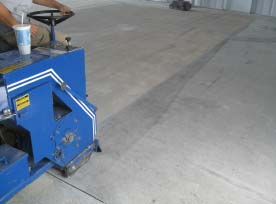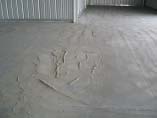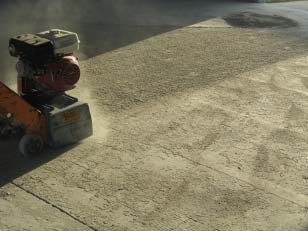 Loading... Please wait...
Loading... Please wait...Categories
- Home
- Knowledge Center
- Surface prep
Surface prep
Surface Preparation Overview
Experts agree surface preparation is the most important and critical step of any job. This is especially true when coatings are involved. Surface preparation will save you time and money in the long run, and can substantially reduce the possibility of coating failure and costly rework.
The key to a successful project is successful surface preparation. Why do you need surface preparation? The prepared area must be able to accept adhesion of a coating and provide the right amount of profile, or “tooth” for the coating. Surface preparation is the key to this process!
Shot Blasting
Shot blasting is a cost-effective and environmentally friendly method for preparing concrete surfaces. This labor and time-saving process strips, cleans and profiles simultaneously. It leaves the surface immediately ready for the application of coatings or overlays—eliminating drying time and costly disposal procedures associated with other surface preparation methods such as acid etching.
Shot blasting is the preferred method of surface preparation, recommended by most coating manufacturers. It produces excellent bonding characteristics that promote reduced coating failure and maximum floor life.
Different surface profiles can be achieved by varying shot size, shot flow rate and machine travel speed.

Diamond Grinding
Diamond grinders use horizontally rotating disks to level, smooth or clean a concrete surface. A diamond tipped or other type of abrasive wheel (such as a litex disc) is mounted on the grinder. The grinder may have single or multiple heads (typically up to 3)
Grinders:
- Remove coatings or adhesive residues
- Smooth or flatten concrete slabs (including troublesome curled expansion joints), and
- Remove surface imperfections.
For decorative concrete applications, use the machines to polish concrete to a high shine or to restore old slabs for architectural finishes.
Depending on the type of abrasive wheel used on the grinder, it can be used to lightly prepare the surface (especially useful when applying thin coatings) or can quickly remove mastics, epoxies, urethane, paint and thick coatings. Special types of multi-headed grinders can be outfitted with carbide tipped slicers to quickly cut through heavy, built-up adhesives, elastomeric coatings, waterproof membranes and more.
 |
 |
Acid Etching
Contractors and manufacturers are split between roughening the concrete by mechanical profiling (shot blasting and diamond grinding) or acid etching. Large or difficult surfaces will usually be mechanically profiled and is the industry standard. Acid etching can provide adequate surface preparation for horizontal installations of coatings, and toppings in areas that are well ventilated and require a spark and / or dust free environment. However, they will not remove petroleum-based products or animal vegetable oils from the concrete and is usually the last resort in surface preparation.
After acid etching is done- the surface must be fully neutralized. Bonding problems can occur if acidic residue remains on the concrete.
ASTM D 4262-83 is the test method for pH for chemically cleaned or etched concrete surfaces to test for moisture.
Mechanical profiling is the method of choice. Acid etching should only be done when no alternative means of preparation is possible. Again, the safest measure is to follow the floor coating manufacturer’s installation instructions.
Scarifying
Scarifiers are versatile, surface preparation tools used for concrete, and asphalt surfaces. Scarifiers use steel or carbide tipped cutters (in various shapes, depending on application) thatare loaded on shafts placed around the perimeter of a cylindrical drum. As the drum rotates, the cutters impact the surface at a high speed, fracturing the coating and/or contaminants and abrading the concrete surface.
Scarifiers are used for repairing common slab problems, such as:curled joints, high spots, uneven slabs, burned slabs due to over-troweling, trowel marks, and damage due to weather.
They remove oil, contaminants, traffic lines, epoxy coatings or paint. They are suitable for smoothing uneven surfaces and trip hazards, or for cutting safety grooves in ramps, walkways and loading docks. Scarifing is a very rough way of prepping a surface prior to diamond grinding.

Scraping & Stripping
Scrapers have come a long way since flimsy hand scrapers or using attachments on skid-steers. No longer is a jack hammer the most efficient way to remove tile, tile mortar and grout beds.
Walk-behind, powered strippers and ride-on scraping machines which are the fastest and most efficient ( Costs approx $1,000.00 per 24 hour rental) have made flooring removal and removal of other materials much easier, faster and more effective. Even hand scrapers are now contractor-tough with spring steel blades and comfortable, ergonomic handles. These tools use razor sharp blades or teeth to slide under, fracture or otherwise remove unwanted materials from the surface. Different blades and teeth are designed for different removal applications from carpet to tile to wood, to coatings and more.
Scrapers are used to remove a wide range of floor coverings, waterproofing membranes, roofing materials and thick coatings.
Scrapers can remove rubber, epoxy, thin-set mortar, elastomeric coatings, adhesives and more.
Cutting
Saws are pretty straightforward - they all cut - but did you know that there are specialized saws for different applications? Using these tools can make your life a lot easier!
Crack and Joint Repair: Crack Chasing and Joint Cleanout Saws

Dust Collectors
Dust collectors reduce airborne dust created during surface preparation and repair jobs, helping to provide a cleaner work environment and increased productivity. Dust collectors are specifically designed for the rigors of commercial/contractor use, with powerful motors for increased air flow, heavy duty filters, and components that are protected from dust and debris for longer life.
Dust collectors are system matched for best performance. A range of vacuums are available for hand tools, as well as walk-behind surface preparation equipment.

